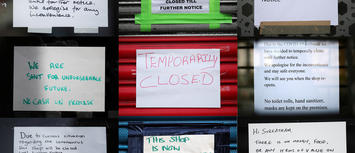
The COVID-19 pandemic has highlighted class inequalities. Commentators in the US, UK, and Australia are acknowledging that working-class people are more likely to suffer as a result of both the virus and the measures put in place to contain its spread.
Workers face increased risk of exposure to the virus because many have no choice but to be in regular face-to-face contact with people who might be infected. Workers in hospitals are at especially high risk, and while the majority of doctors might be middle class, most nurses, care assistants, cleaners, porters, and the people preparing and serving meals are working class. These front-line workers simply can’t stay at home.
Working-class people also have more difficulty accessing health care. In the US, working-class people often lack access to adequate health care, and they might not be able to afford treatment if they can get it. In the US, working-class people are also less likely to have sick pay and may have no choice but to go into work when sick. Existing health disparities put people of colour in the US at far greater risk of serious illness if they contract COVID-19. The UK and Australia have universal health care systems, but there are still discrepancies in access to treatment. In the UK, for example, Tory austerity measures have severely diminished the capacity of the National Health Service (NHS), so the system that cannot cope with the influx of infected patients despite the efforts of NHS workers. And racial disparities exist in these countries, too. Indigenous Australians are also at greater risk from the virus due to the racial gap in health outcomes.
Testing also reflects class inequities. While many working-class people don’t have access to tests, more elite members of society have had no trouble at all in getting tested and receiving immediate treatment. Prince Charles was infected and isolated himself at the royal family’s private estate in Scotland. No doubt he had excellent medical care available. In Australia the health system is less overloaded, but celebrities there have had no trouble getting tested even as others have had requests turned down.
Class differences also make for different experiences of quarantine, social isolation, and the recommended hygiene routines such as hand washing. Middle-class people are more likely to be able to work at home. Most have good internet access and space for at-home leisure activities such as home-gyms or gardens to escape to. Quarantine looks very different for people living in households with little physical space, and many cannot afford or don’t have access to the internet. The shift to online learning for school and tertiary students has really exposed the digital divide. And the guidelines on handwashing can only be met if people have access to clean running water and soap.
Add to all of this the millions of working-class people who have lost their jobs due to new restrictions on “non-essential” busineses. In Australia, the government announced that all bars and night clubs would close, and restaurants and cafes could only serve take out. Overnight, thousands were unemployed. More people were stood down by retail outlets, the travel industry (such as airlines), and other businesses no longer able to operate due to the restrictions or the sudden and unsustainable drop in trade. This sent thousands of people to Centrelink (the Australian social security offices) to apply for unemployment benefit. The system has been unable to cope with the mass applications, and people have been left without any income. The Australian government’s response in the form of a wage subsidy will help some, but not all, of the laid-off workers.
For working-class people, these inequalities come as no surprise. People on low incomes know only too well how easy it is to be down to their last dollar and understand the implications of precarity. Class divisions are only a surprise to people who have never struggled financially or experienced class discrimination.
Read the rest of this piece at Working Class Perspectives
Sarah Attfield, University of Technology Sydney, is editor of the Journal of Working-Class Studies.












